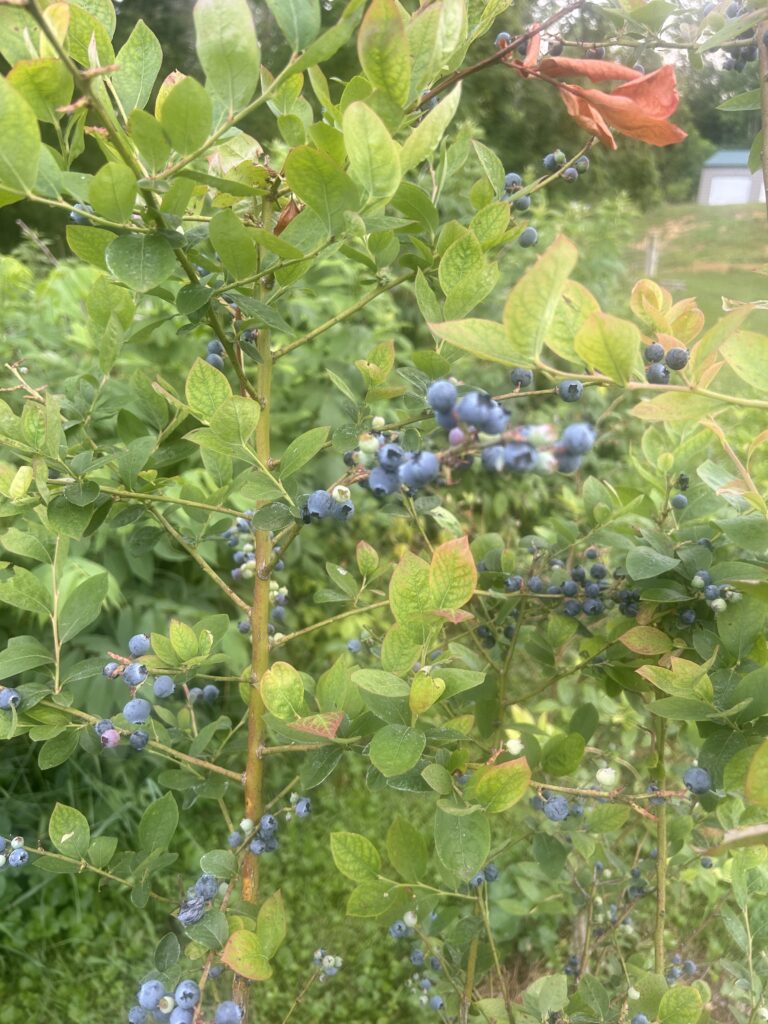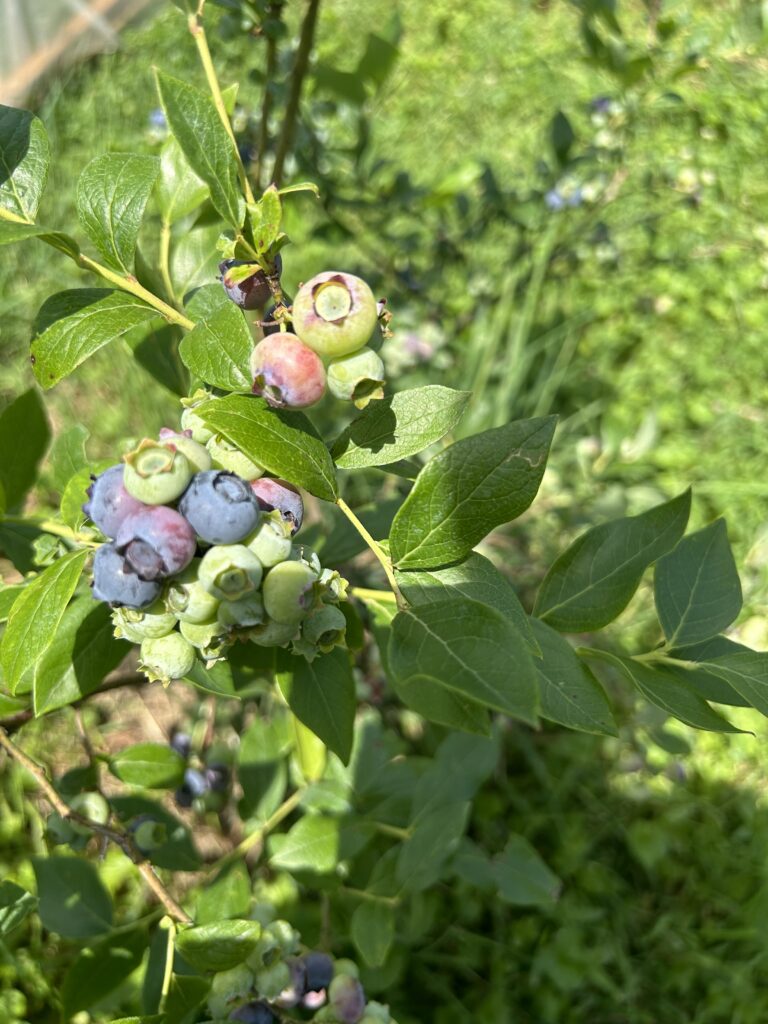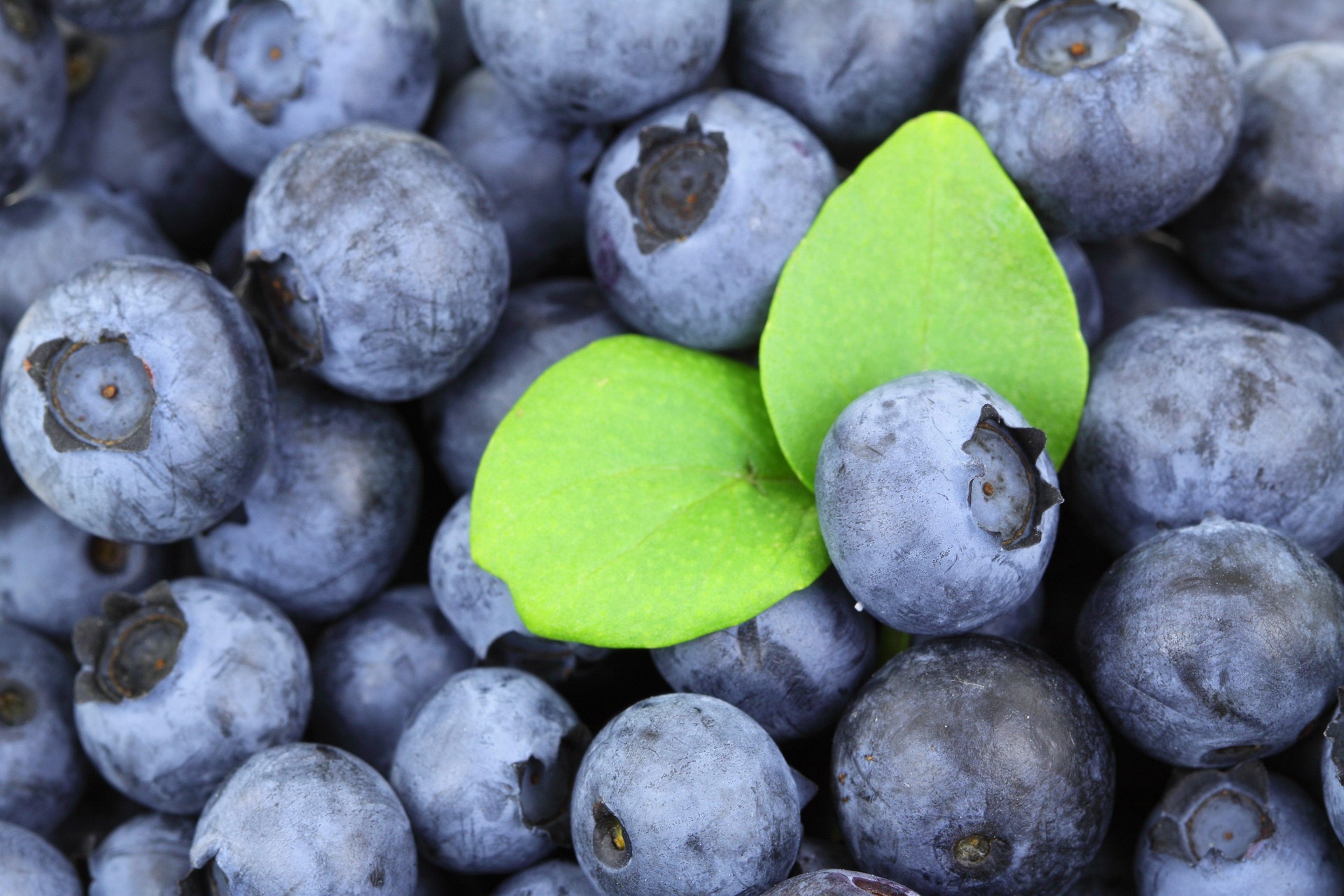Blueberries are one of the easiest fruiting shrubs to grow in home gardens, requiring minimal maintenance once established. They’re naturally pest-resistant, long-lived, and can produce fruit for decades with proper care. Blueberries are packed with antioxidants, vitamins, and fiber, making them a healthy snack right off the bush. Beyond the harvest, blueberry bushes offer year-round visual appeal: delicate white spring flowers, lush green summer foliage, juicy blue fruit, and brilliant red or orange fall color. Most Importantly they are delicious.
Types of Blueberries
Blueberry bushes come in several types, each suited to different climates, soil conditions, and space. Here’s a breakdown of the main types of blueberry bushes, including their characteristics and growing zones:
1. Highbush (Northern Highbush)
- Height: 4–7 feet
- Zones: 4–7
- Chill Hours: 800–1,000+
- Best for: Most of the northern U.S.
- Notes: Most common cultivated variety; high yield and large berries.
Popular Varieties:
- Bluecrop – Reliable, midseason, classic flavor
- Jersey – Late-season, sweet, very productive
- Duke – Early-season, cold-hardy, firm berries
2. Southern Highbush
- Height: 3–6 feet
- Zones: 7–10
- Chill Hours: 150–500
- Best for: Warmer southern climates
- Notes: Heat-tolerant hybrids of Northern Highbush and native Southern species.
Popular Varieties:
- Misty – Early producer, excellent flavor
- O’Neal – Very sweet, early harvest
- Sunshine Blue – Compact, ornamental, low chill (150 hrs)
3. Rabbiteye
- Height: 6–10 feet
- Zones: 7–9
- Chill Hours: 300–600
- Best for: Hot, humid areas of the South
- Notes: Drought-tolerant, needs cross-pollination for best yield
Popular Varieties:
- Climax – Early season, good pollinator
- Tifblue – Mid to late season, cold-hardy
- Premier – High yield, flavorful
4. Lowbush (Wild Blueberries)
- Height: 6–18 inches
- Zones: 3–6
- Chill Hours: High
- Best for: Cold northern climates and naturalized plantings
- Notes: Small berries, intense flavor; used for groundcover and commercial wild blueberry production
Popular Varieties:
- Often not named—sold as wild or native lowbush blends
5. Half-High
- Height: 2–4 feet
- Zones: 3–6
- Chill Hours: Moderate to high
- Best for: Northern regions with extreme winters
- Notes: Cross between highbush and lowbush—cold hardy and manageable size
Popular Varieties:
- Northblue – Compact, sweet berries
- Northcountry – Small plant, good flavor, productive

Best blueberries to grow
Zone 7 is a sweet spot for blueberry growing but Zones 6-9 are also great for blueberries— in zone 7 you have the flexibility to grow Northern Highbush, Southern Highbush, and even Rabbiteye varieties, depending on your soil and microclimate. Here’s a list of the best blueberry varieties , broken down by type and use:
Northern Highbush (Reliable & Cold-Hardy)
Best if your winters are cool and you have acidic, well-drained soil.
Duke
- Ripens: Early
- Flavor: Mild, sweet
- Notes: Cold-hardy, consistent producer
Bluecrop
- Ripens: Midseason
- Flavor: Balanced, slightly tart
- Notes: Classic variety; good yield and disease resistance
Legacy
- Ripens: Late
- Flavor: Outstanding, complex
- Notes: High yield and excellent for fresh eating
Southern Highbush (Lower Chill, Warmer Winters)
Great for mild winters or early harvests .
Sunshine Blue
- Ripens: Midseason
- Flavor: Very sweet
- Notes: Compact (good for containers), evergreen in mild winters
O’Neal
- Ripens: Very early
- Flavor: Rich and sweet
- Notes: Excellent quality, early pollinator
Misty
- Ripens: Early
- Flavor: Light and sweet
- Notes: Attractive bush with bluish-green foliage
Rabbiteye (Drought-Tolerant & Heat-Hardy)
Ideal for Zone 7, especially if you have sandy or loamy soil and hot summers.
Climax
- Ripens: Early
- Flavor: Sweet-tart
- Notes: Needs cross-pollination
Tifblue
- Ripens: Late
- Flavor: Mild
- Notes: One of the most cold-hardy Rabbiteyes
- Premier
- Ripens: Midseason
- Flavor: Sweet and firm
- Notes: Heavy producer, great for fresh eating or preserving
Planting Considerations
Growing blueberries successfully requires careful attention to soil, spacing, sunlight, and watering. They’re not difficult plants, but they are picky about a few key things. Here’s what you should consider before planting:
1. Soil Requirements
- pH: Blueberries need acidic soil, ideally between 4.5 and 5.5.
- Test your soil first. Most native soils in are too alkaline.
- Amend with sulfur, peat moss, or pine bark fines if needed.
- Drainage: Must be well-draining—blueberries hate wet feet.
- Raised beds or mounds are ideal in heavy clay soil.
- Organic matter: They thrive in loose, rich soil with lots of organic material.
2. Sunlight
- Full sun (6–8+ hours/day) is critical for good fruit production and flavor.
- A bit of afternoon shade is okay in hotter areas .
3. Watering
- Blueberries have shallow root systems and need consistent moisture.
- Water 1–2 inches per week during the growing season.
- Mulch heavily (2–4 inches deep) with pine needles, wood chips, or shredded bark to retain moisture and keep soil cool.
4. Spacing
- Highbush varieties: Space 4–6 feet apart in rows 8–10 feet apart.
- Rabbiteye: Space 6–8 feet apart (larger shrubs).
- Southern Highbush & compact types (e.g. Sunshine Blue): 3–4 feet apart or in containers.
5. Pollination
- While many blueberries are self-pollinating, planting at least two different cultivars that bloom at the same time boosts yield and berry size.
- Example: Plant Duke and Bluecrop together for northern highbush types.
- Rabbiteyes require cross-pollination, so mix varieties like Premier and Tifblue.
6. Site Preparation Tips
- Remove weeds before planting—they compete aggressively with blueberries.
- Mix in peat moss or composted pine bark to improve acidity and structure.
- Avoid fertilizers high in nitrogen early on; blueberries prefer slow, balanced feeding once established.
Pollination chart blueberries
Although some blueberries are self pollinating, even those will benefit from pollination partners.
Blueberry Pollination Chart, which includes compatible varieties for optimal cross-pollination:
Blueberry Pollination Chart
| Variety | Compatible Pollinators | Bloom Time | Self-Pollinating? |
|---|---|---|---|
| Duke | Bluecrop, Legacy, Legacy | Early | Yes |
| Legacy | Duke, Bluecrop, Legacy | Mid-Late | Yes |
| Bluecrop | Blueray, Jersey, Elliot | Mid | Yes |
| Jersey | Bluecrop, Blueray, Duke | Late | Yes |
| Blueray | Bluecrop, Jersey | Mid | Yes |
| Elliot | Bluecrop, Blueray | Late | Yes |
| Sunshine Blue | Misty, Pink Lemonade | Mid | Yes |
| Misty | Sunshine Blue, Pink Lemonade | Early | Yes |
| Pink Lemonade | Sunshine Blue, Misty | Mid | No |
| Tifblue | Powderblue, Brightwell | Late | No |
| Powderblue | Tifblue, Brightwell | Late | No |
| Brightwell | Powderblue, Tifblue | Mid | No |
| Climax | Premier, Austin | Early | No |
| Premier | Climax, Brightwell | Mid | No |
| Austin | Climax, Brightwell | Early | No |
Note: The bloom times are approximate and can vary based on local climate conditions.
Pollination Tips:
- Proximity: Plant compatible varieties within 3–6 feet of each other to facilitate effective pollination.
- Timing: Ensure that the bloom times of the varieties overlap to allow for cross-pollination.
- Diversity: While some varieties are self-pollinating, cross-pollination can lead to larger fruit and higher yields.
My personal favorite
Legacy is one of the best blueberries around for many reasons. Legacy blueberries are highly prized for their exceptional flavor, combining sweetness, firmness, and a rich, aromatic quality that makes them ideal for fresh eating. As a late-season Northern Highbush variety with some Southern Highbush traits, Legacy performs remarkably well in USDA Zone 7, offering both cold hardiness and tolerance to heat and humidity. The plants are vigorous, upright growers that produce consistently high yields of large, flavorful berries. They’re also relatively disease-resistant, especially to root rot, and self-fertile—though yields improve when cross-pollinated with compatible varieties like Bluecrop or Jersey. With their excellent fruit quality, reliable performance, and extended harvest season it is hard to beat Legacy.


No responses yet